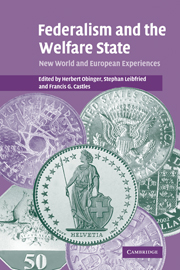Book contents
- Frontmatter
- Contents
- List of figures
- List of tables
- List of contributors
- Preface
- Note on illustrations
- 1 Introduction: federalism and the welfare state
- Part 1 New World experiences
- 2 Australia: federal constraints and institutional innovations
- 3 Canada: nation-building in a federal welfare state
- 4 The United States: federalism and its counter-factuals
- Part 2 European experiences
- Part 3 Conclusion
- Index
3 - Canada: nation-building in a federal welfare state
Published online by Cambridge University Press: 22 September 2009
- Frontmatter
- Contents
- List of figures
- List of tables
- List of contributors
- Preface
- Note on illustrations
- 1 Introduction: federalism and the welfare state
- Part 1 New World experiences
- 2 Australia: federal constraints and institutional innovations
- 3 Canada: nation-building in a federal welfare state
- 4 The United States: federalism and its counter-factuals
- Part 2 European experiences
- Part 3 Conclusion
- Index
Summary
Introduction
Canadians developed their version of the welfare state in the context of a vibrant federal state, with strong governments at both the federal and provincial level. Their experience highlights in fascinating ways the reciprocal interplay between federalism and social policy. In comparative context, the Canadian case underscores the need for more nuanced analysis than is found in much of the comparative literature of the welfare state, which is summarized in the introduction to this book. Attention normally focusses on simple dichotomies: federal versus non-federal, centralized versus decentralized, concentrated power versus multiple veto points. It is widely argued that federal, decentralized and/or fragmented decision-making inhibited the expansion of the welfare state in the twentieth century, but has slowed the processes of restructuring in the contemporary period. Such propositions do find echoes in Canada. For example, decentralization helped to slow the pace of development in the first half of the twentieth century.
The primary lessons to be drawn from the Canadian experience, however, emerge from the modern social programmes put in place in the second half of the twentieth century. Canada did not develop a single, integrated public philosophy of federalism in this period, and federal–provincial relations in social policy incorporated three distinct models, each with its own decision rules. At any point in time, governments were shaping or reshaping different programmes according to different rules and processes. Canada therefore constitutes a natural laboratory in which to analyze the implications of different models of federalism.
- Type
- Chapter
- Information
- Federalism and the Welfare StateNew World and European Experiences, pp. 89 - 137Publisher: Cambridge University PressPrint publication year: 2005
- 55
- Cited by

